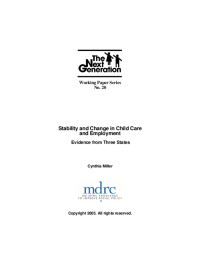Stability and Change in Child Care and Employment
Evidence from Three States
Summary of Key Findings for Working Paper No. 20
In response to falling welfare caseloads and a new emphasis on self-sufficiency, policymakers have begun focusing on programs designed to increase employment retention. Former welfare recipients face a range of obstacles that might easily contribute to job instability, such as limited work experience, low education levels, and the challenges of working and raising children with a limited income. To what extent does unstable child care contribute to employment instability? This paper uses a unique data set consisting of over 3,500 women targeted for welfare-to-work programs in three states to examine child care stability and its association with employment stability among current and former welfare recipients.
Key Findings
- Child care use is fairly stable for this population. Most women in the sample who used care used it fairly consistently.
- Changing arrangements and using multiple types of care in a given month are more common than dropping care, but they do not seem to be indications of instability.
- Child care instability is associated with employment instability. However, the evidence suggests that much of child care instability is caused by employment instability and not the other way around. In addition, transitions out of child care happen fairly infrequently, indicating that they do not account for the majority of transitions out of work.
Conclusions and Implications
As more and more women move off of welfare and into work, it will be important to document and understand factors that either support or hinder their efforts to become self-sufficient. The findings here suggest that child care instability is one of those factors but not a major one. In this case, employment retention programs should continue to consider child care issues but would do best to also focus on additional barriers to keeping jobs, like low education levels and limited work histories. However, the findings do not suggest that child care instability should be ignored. Changing and dropping care, although not necessarily problems from an employment stability perspective, have been found to have negative effects on children.






